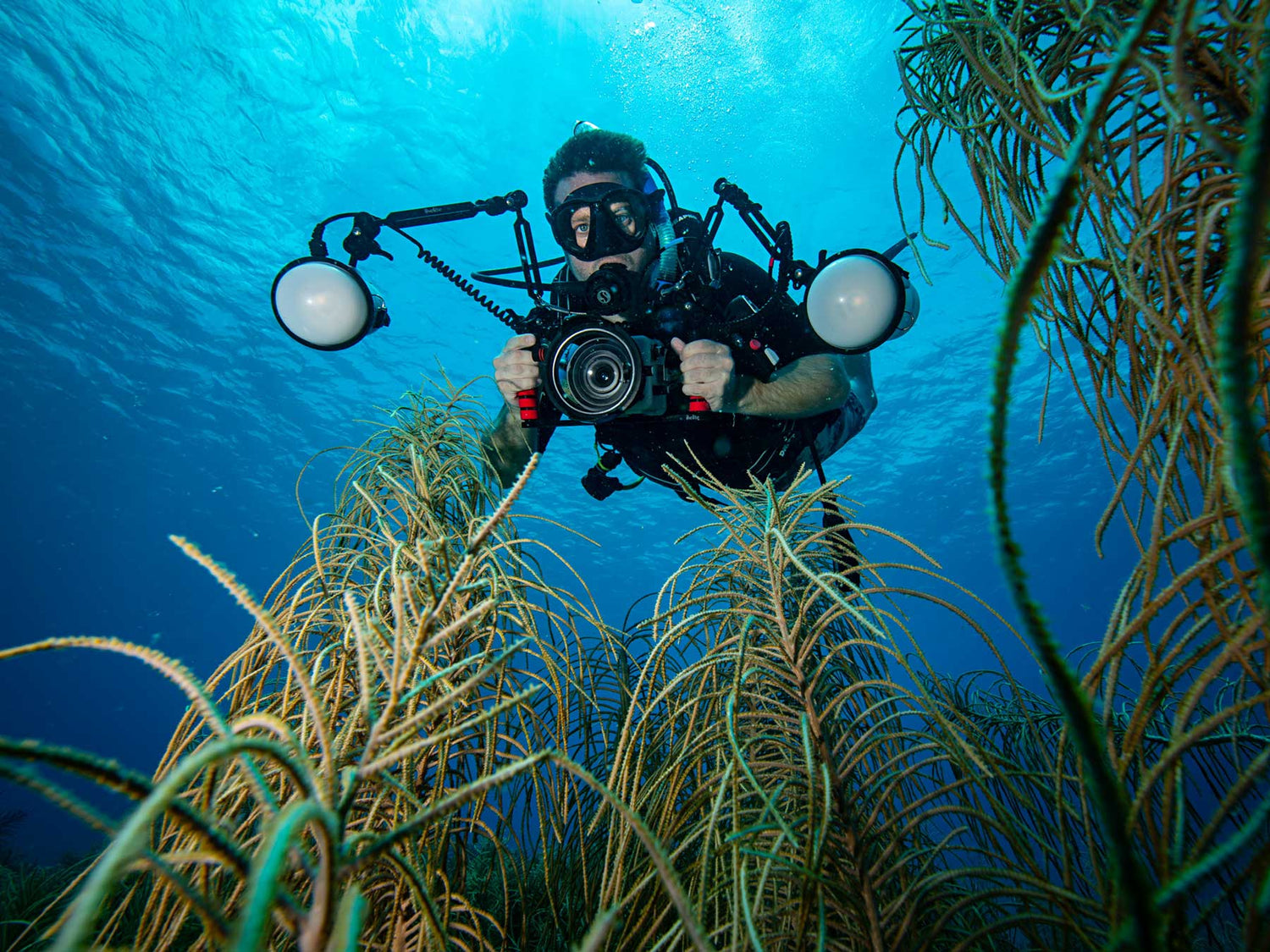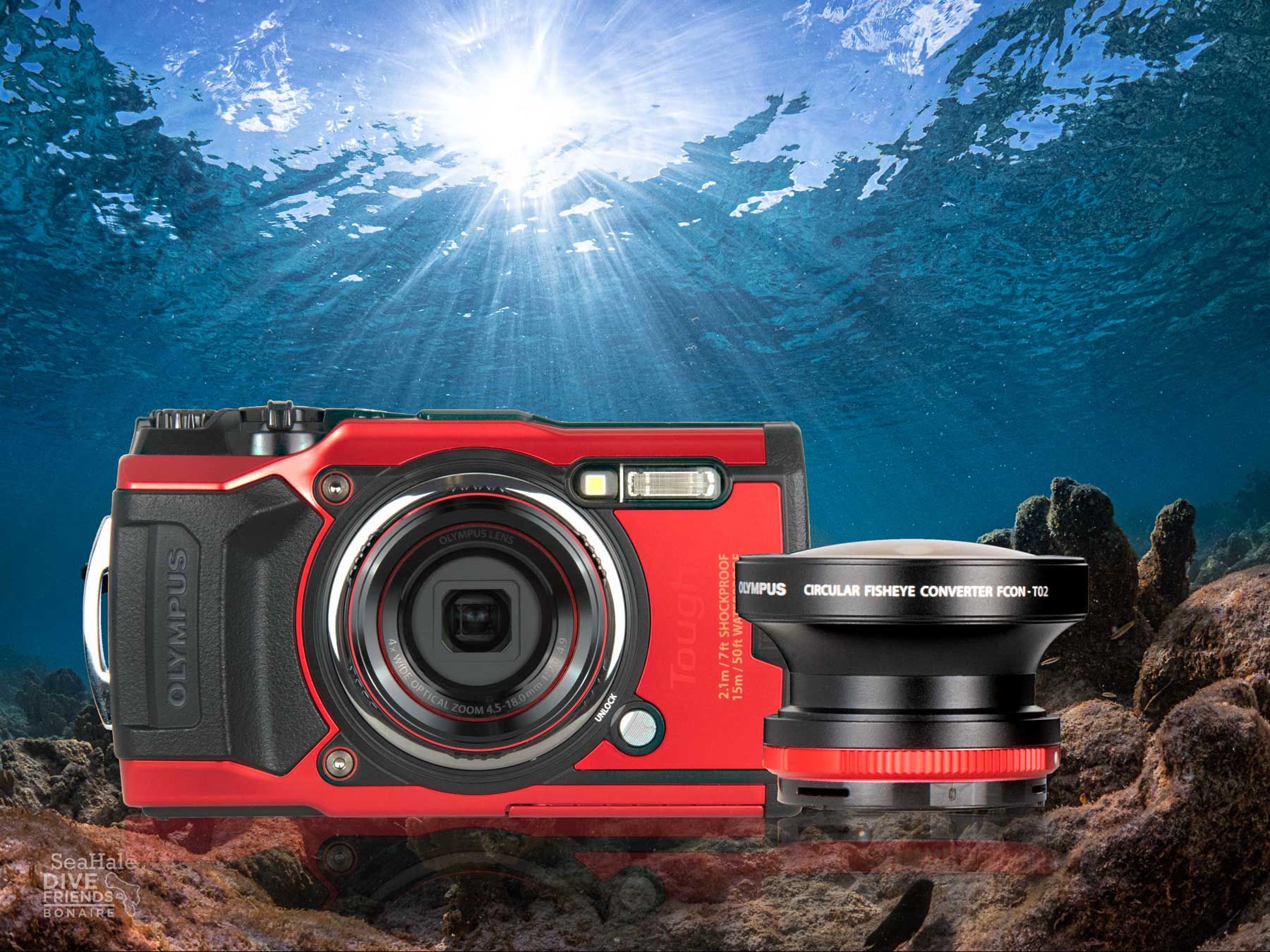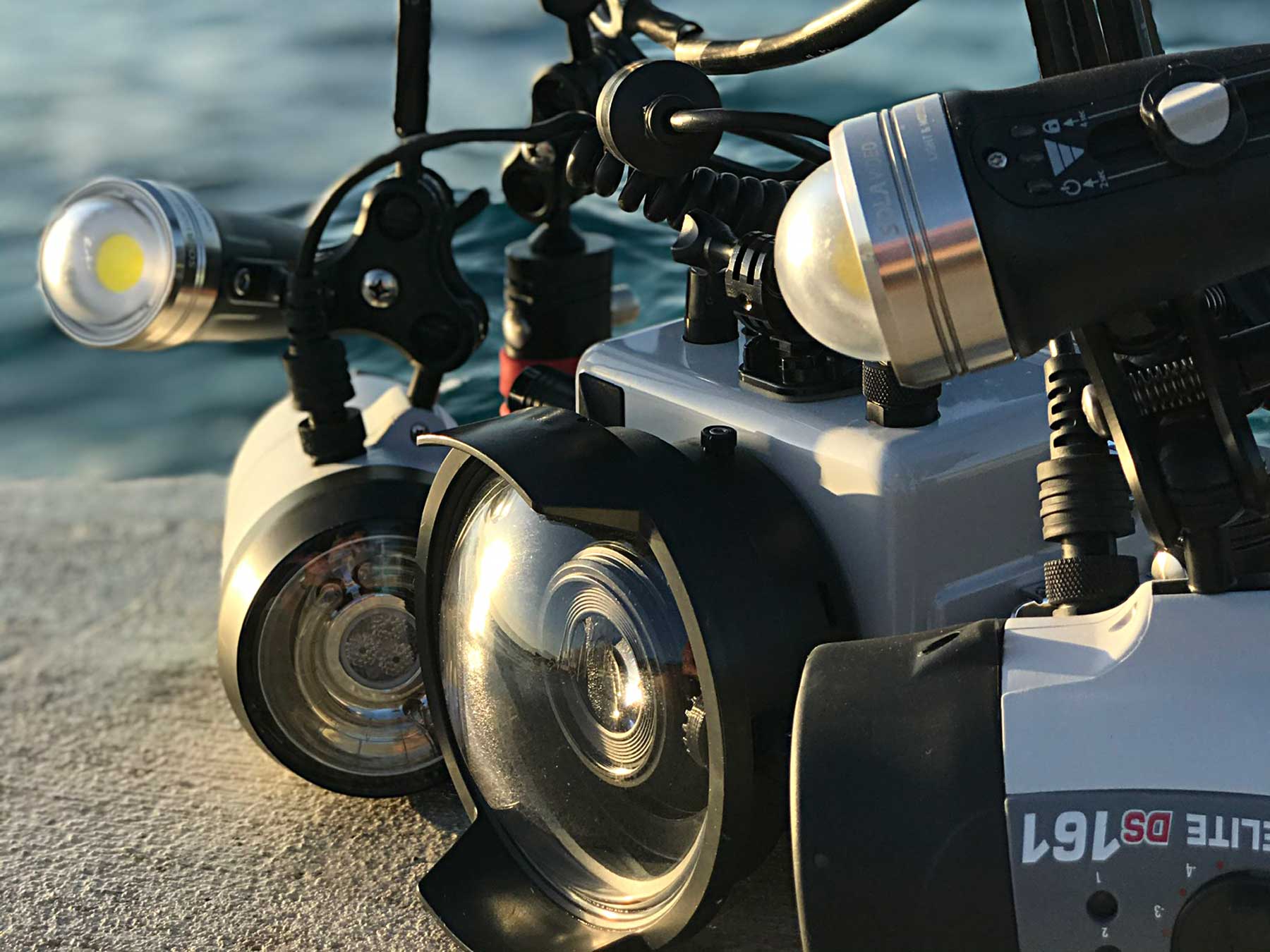By Jean Rydberg
Mid-range cameras fill that sweet spot in underwater imaging, combining imaging quality with portability. Every year we see the release of the best digital cameras ever, and here at Ikelite we're constantly evaluating new models to drill it down to which are the best digital cameras underwater.
You may be asking what's a mid-range camera and is it right for you? Mid-range cameras typically offer manual controls not available on less sophisticated point-and-shoots. But they are not as large and don't have quite as many bells-and-whistles as full-on professional cameras. Mid-range cameras are a great choice for any underwater photographer, because they marry great image and video quality with a compact form that's easier to travel with and maneuver underwater.
We'll run through the top contenders in the mid-range camera category and what makes them good or bad for underwater use. Here we're comparing 6 models that are current going into 2020.

Left-to-right: Canon EOS Rebel SL3 (250D); Sony Cyber-shot RX100 VII; Sony Alpha a6100; Sony Alpha a6600; Olympus OM-D E-M5 III; Olympus OM-D E-M1 II
1 | Canon EOS Rebel SL3 / EOS 250D / EOS 200D Mark II
A compact DSLR with optical viewfinder and interchangeable Canon EF lens mount. Smaller than Canon's standard Rebel series DSLR cameras.
2 | Sony Cyber-shot DSC-RX100 VII
A compact point-and-shoot camera with a built in 24-120mm zoom lens. One of the most popular point-and-shoot camera series ever underwater.
3 | Sony Alpha a6100
The affordable end of Sony's mirrorless camera line with Sony E lens mount.
4 | Sony Alpha a6600
The upper end of Sony's compact mirrorless camera line with Sony E lens mount. The next step up would be a much larger and more expensive Sony full frame mirrorless system.
5 | Olympus OM-D E-M5 III
The middle of Olympus' compact mirrorless camera line with a micro four-thirds lens mount.
6 | Olympus OM-D E-M1 II
The high end of Olympus' compact mirrorless camera line with a micro four-thirds lens mount. There is no real next step up in the Olympus product line.

Selection Criteria
These cameras were grouped because of their size, price point, quality, and positioning in their respective manufacturers' product lines.
All of these cameras were released in 2019 with the exception of the OM-D E-M1 II which was released back in 2016. Needless to say there are rumors of the release of a successor, as the original E-M1 was released 3 years prior in 2016. Nothing has been announced as of November 2019.
Let's get straight down to it.
Image Sensor
Larger image sensors have more surface area to capture light when you take a photo. A larger image sensor generally provides you with a more clear image with shallower depth of field.

Comparing sensor sizes in terms of surface area.
An APS-C or "crop sensor" is the largest and most common sensor size before stepping up to a "full frame sensor" camera like a Canon EOS 5D Mark IV, Nikon D850 / Z6 / Z7, or Sony Alpha a7R IV.
Like "full frame", the name APS-C (which stands for Advanced Photo System Classic) is a carry over from the days of film. As if the name weren't already devoid of useful meaning, the equivalent size is actually slightly different between Canon, Nikon, and Sony, with the latter two being about 12% larger.
The four-thirds sensor size was designed specifically for digital interchangeable lens cameras and is common to Olympus and Panasonic cameras. It has about 2/3 the surface area of the Canon APS-C.
A 1" type sensor is found on point-and-shoot cameras like the Sony Cyber-shot RX100 series and the Canon PowerShot G7 X series, among others. It's about as large as you will get in a pocket-friendly camera, with roughly 1/3 the surface area of the Canon APS-C sensor.
|
Canon SL3 250D |
Sony RX100 VII |
Sony a6100 |
Sony a6600 |
Olympus E-M5 III |
Olympus E-M1 II |
|
| Max resolution in pixels | 6000 x 4000 | 5472 x 3648 | 6000 x 4000 | 6000 x 4000 | 5184 x 3888 | 5184 x 3888 |
| Effective pixels | 24 megapixels | 20 megapixels | 24 megapixels | 24 megapixels | 20 megapixels | 20 megapixels |
| Sensor size | APS-C (22.3 x 14.9 mm) | 1" (13.2 x 8.8 mm) | APS-C (23.5 x 15.9 mm) | APS-C (23.5 x 15.9 mm) | Four thirds (17.4 x 13 mm) | Four thirds (17.4 x 13 mm) |
| 4K UHD video | Yes | Yes | Yes | Yes | Yes | Yes |
Pixel count affects your print and display resolution. Generally any camera today will have plenty of pixels for whatever you're doing as long as you're shooting in a high quality image mode like RAW. Here are a couple of basics:
Print materials require 300 dpi (dots per inch), so a 6000 x 4000 image will reproduce perfectly up to 20 x 13.3 inches and pretty well up to about 40 x 30 inches.
4K ultra high definition (UHD) displays have a resolution of 3840 x 2160 pixels.
Cropping a photo will reduce its effective resolution so capturing images on a larger sensor has a definite advantage in post production.
Lens Quality
The Sony Cyber-shot RX100 VII is the only camera we're comparing that has a fixed lens. The 24-120mm zoom range is well suited for underwater and surface photography. Its length is a little problematic for use with external wide angle lenses. To address this, the housing has a wide angle port option (MSRP $135) which reduces the lens' usable zoom range underwater but allows the effective attachment of external wide angle lenses.
The other cameras we're comparing are interchangeable lens cameras. The Canon Rebel SL3 (250D) has by far the best lens selection among these cameras. The Tokina 10-17mm Fisheye ($449), Canon 8-15mm Fisheye ($1,249), Canon 60mm Macro ($469) and Canon 100mm Macro ($899) lenses are some of the most revered for underwater photography. For wide angle, the Tokina 10-17mm is a top staff pick because of the fantastic combination of size, price, and image quality.
Sony is lacking a good E-mount fisheye zoom lens option. The Sony 90mm Macro (MSRP $1099) is a wonderful macro lens with relatively quick, sharp focus. Sony E-mount mirrorless cameras can accept Canon lenses using a Metabones adapter, but speed and autofocus performance will suffer a little. The adapter also adds a little bulk to your set-up both above and below water.
Olympus supports nice quality rectilinear wide angle zoom lenses including Olympus 7-14mm ($1299), Panasonic 8-18mm ($1098), and Olympus 12-40mm ($999). A rectilinear lens gives a more natural perspective of straight lines and large subjects, but isn't as sharp as a fisheye underwater. Olympus has decent macro options with a 30mm ($299) and 60mm ($499).
Read more: Why You Need a Fisheye Lens Underwater
Flash Use
A professional quality underwater flash (strobe) is one of the best investments that impact your image quality. When choosing an underwater system it's important to look at TTL strobe options. A TTL strobe will act like a surface flash; it will vary its intensity instantly and accurately for each photo by receiving information directly from the camera.
The alternative is manual strobe power. Usually "manual" is a good word in underwater photography - we want to manually set our camera's exposure settings like ISO, aperture, and shutter speed. While it's a necessary fallback for systems that don't have a good True TTL option, it's not the most efficient or effective way to shoot strobes underwater.
|
Canon SL3 250D |
Sony RX100 VII |
Sony a6100 |
Sony a6600 |
Olympus E-M5 III |
Olympus E-M1 II |
|
| Built-in Flash | Yes | Yes | Yes | No | No | No |
| True TTL | Built-in | No | Optional | Optional | Optional | Built-in |
The primary disadvantage of the lack of a built-in flash is for surface photography. A fill flash is important in a variety of topside shooting, especially indoors. Lack of a useable built-in flash really offsets the size advantages offered by a more compact camera body design.
Composing Your Shot
There are two basic ways to compose your shot underwater: either using a camera's rear LCD screen, or by looking through a viewfinder. All of these cameras have the now-standard bright 3" diagonal rear screen for composing, shooting video, and image review.
If you've ever shot using an LCD out in the sunlight, you know that they aren't ideal for composing and reviewing images in an outdoor environment. It can be difficult to see a rear LCD in bright sunlight. The housing provides a dark environment to bring it out as best as possible, but it can still be difficult to use if the sun is to your side or behind you.
The three Sony cameras are limited to use of the rear LCD screen for composing and reviewing.
Both Olympus models feature an electronic viewfinder (EVF) which may be used for both composing and reviewing your images. Image review in the EVF allows you to see better detail in your image when reviewing in the moment compared to a rear LCD screen.
The Canon Rebel SL3 250D features an optical viewfinder which some say produces a more lifelike representation of the scene than newer EVFs. Use of an optical viewfinder dramatically conserves battery life.
Either EVF or optical viewfinders may be enhanced by adding the awesome 45º Magnified Viewfinder, or the 180º Straight Enhanced Magnifying Viewfinder.
Read more: Straight vs 45 Degree Magnified Viewfinder for Underwater Shooting

Housing sizes compared. On the left is a point-and-shoot housing for the Sony Cyber-shot RX100 series. The middle housing represents a compact mirrorless or compact DSLR camera like the Rebel SL3. The housing on the right represents a full frame mirrorless or DSLR camera like the Sony a7, Canon 5D IV, or Nikon D850.
Battery Life and Size
Your intuition is 100% correct, a larger number of shots per battery charge is always better. The Canon Rebel SL3 250D is a clear leader in this category, almost on par professional grade DSLR cameras like the 5D Mark IV. Extended battery life is key if you want to avoid making battery changes and increasing your risk exposure on a wet boat deck.
All of these cameras are small and lightweight. Only the Sony RX100 VII is truly small enough to fit in your pocket, but all of the others are easily carried in a small personal bag without feeling like you brought the boat anchor along with you on your shore excursion.
|
Canon SL3 250D |
Sony RX100 VII |
Sony a6100 |
Sony a6600 |
Olympus E-M5 III |
Olympus E-M1 II |
|
| Battery Life (CIPA) | 1070 | 260 | 420 | 810 | 310 | 440 |
| Weight | 449 g | 302 g | 396 g | 503 g | 414 g | 574 g |
| Dimensions | 122 x 93 x 70 mm | 102 x 58 x 43 mm | 120 x 67 x 59 mm | 120 x 67 x 69 mm | 125 x 85 x 50 mm | 134 x 91 x 67 mm |
It's important to note that all of these systems are just a fraction of the size and weight of a DSLR or full frame mirrorless camera rig underwater. In fact, they're about half the size and weight. Which means it's easier to pack, easier to wheel your luggage, easier to get to the water, and easier to swim around.
Price
"Money is no object" said no rich man ever. Getting ready to shoot underwater is a little bit like planning for retirement: it's important to make the right investments. Any of these cameras - and likewise any manufacturers' housings - are capable of similarly high quality underwater images and videos in the right hands. The top 3 things that you should be thinking about investing in are 1) good glass; 2) good strobes; 3) good photo opportunities.
|
Canon SL3 250D |
Sony RX100 VII |
Sony a6100 |
Sony a6600 |
Olympus E-M5 III |
Olympus E-M1 II |
|
| Camera MSRP with lens (US) |
$749 with 18-55 lens |
$1,200 with 24-120 lens |
$850 with 16-50 lens |
$1,800 with 18-135 lens |
$1,799 with 14-150 lens |
$2,699 with 12-40 lens |
| Housing MSRP with port (US) | $1,295 | $495 | $1,125 | Not available | TBD | $1,645 |

For underwater use, the Canon Rebel SL3 (250D) really pulls out in front of the other compact mid-range cameras on the market. We love its combination of performance, handling, and affordability. Mirrorless is starting to take over in full frame imaging, but this tiny DSLR wins the compact category.
Conclusion
The Canon Rebel SL3 250D is our top staff pick for the best mid-range camera underwater. It absolutely has the best set of features and best performance-to-value ratio of any mid-range system on the market in 2019-2020.
The Sony Cyber-shot RX100 series is beloved for underwater, but for about the same money and size you can get into the Rebel SL3 with better image quality and 5x the battery life. If the smallest size is your #1 driving factor then we recommend going with the Olympus Tough TG-6 instead.
We love Sony full frame mirrorless but right now their compact mirrorless options don't stack up quite as well. Autofocus is frustrating and a bit hit-and-miss.
Olympus has good lens selection and image quality but simply doesn't provide the same value in the mid-range segment that they do in the compact segment with the Tough TG-6 camera. The four-thirds sensor size is smaller than APS-C and also means you're "stuck" in the Olympus and Panasonic family once you've invested in their glass.
Have any questions about these systems, or any other camera you're considering? Ready to move forward and want to select the perfect accessories for your shooting style? Get the best fit for you. Contact your personal photo pro today by emailing or calling us!
 Jean Rydberg is the President & CEO of Ikelite. She has lived her whole life in landlocked Indianapolis, Indiana, but is no stranger to the water as a daughter of Ikelite’s founder Ike Brigham. She has traveled around the world shooting and testing gear and enjoys new challenges in both photography and diving. Jean loves to learn about the creative ways photographers achieve their visions. More than anything she wants to show aspiring underwater photographers that excellence is attainable with any system. When she's not working she's spending time with her husband and two daughters.
Jean Rydberg is the President & CEO of Ikelite. She has lived her whole life in landlocked Indianapolis, Indiana, but is no stranger to the water as a daughter of Ikelite’s founder Ike Brigham. She has traveled around the world shooting and testing gear and enjoys new challenges in both photography and diving. Jean loves to learn about the creative ways photographers achieve their visions. More than anything she wants to show aspiring underwater photographers that excellence is attainable with any system. When she's not working she's spending time with her husband and two daughters.
Additional Reading
First Look Canon EOS Rebel SL3 250D Underwater Housing
How to Accessorize the Canon EOS SL3 250D Underwater System
Canon EOS Rebel SL3 250D Underwater Photos
Canon EOS Rebel SL2 200D Underwater Photos
Canon EOS Rebel SL1 100D Underwater Photos
Sony RX100 VI Underwater Photos
First Look Sony Alpha a6400 Underwater Housing
Sony Alpha a6400 Underwater Photos
Olympus OM-D E-M1 Mark II Underwater Housing & Camera Review
First Look Olympus Tough TG-6 and FCON-T02 Circular Fisheye Lens














